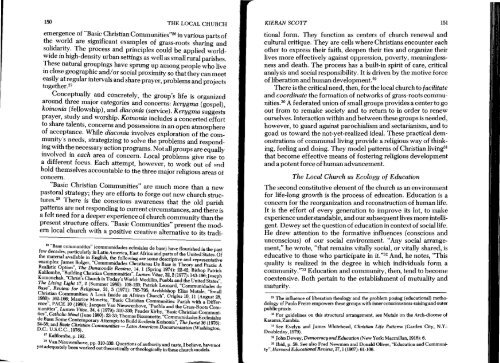The Local Church as an Ecology of Human Development - Fordham ...
The Local Church as an Ecology of Human Development - Fordham ...
The Local Church as an Ecology of Human Development - Fordham ...
- No tags were found...
You also want an ePaper? Increase the reach of your titles
YUMPU automatically turns print PDFs into web optimized ePapers that Google loves.
150 THE LOCAL CHURCHemergence <strong>of</strong> "B<strong>as</strong>ic Christi<strong>an</strong> Communities"26 in various parts <strong>of</strong>the world are signific<strong>an</strong>t examples <strong>of</strong> gr<strong>as</strong>s-roots sharing <strong>an</strong>dsolidarity. <strong>The</strong> process <strong>an</strong>d principles could be applied worldwidein high-density urb<strong>an</strong> settings <strong>as</strong> well <strong>as</strong> small rural parishes.<strong>The</strong>se natural groupings have sprung up among people who livein close geographic <strong>an</strong>d/or social proximity so that they c<strong>an</strong> meete<strong>as</strong>ily at regular intervals <strong>an</strong>d share prayer, problems <strong>an</strong>d projectstogether. 27Conceptually <strong>an</strong>d concretely, the group's life is org<strong>an</strong>izedaround three major categories <strong>an</strong>d concerns: kerygma (gospel),koinonia (fellowship), <strong>an</strong>d diaconia (service). Kerygma suggestsprayer, study <strong>an</strong>d worship. Koinonia includes a concerted effortto share talents, concerns <strong>an</strong>d possessions in <strong>an</strong> open atmosphere<strong>of</strong> accept<strong>an</strong>ce. While diaconia involves exploration <strong>of</strong> the community'sneeds, strategizing to solve the problems <strong>an</strong>d respondingwith the necessary action programs. Not all groups are equallyinvolved in each area <strong>of</strong> concern. <strong>Local</strong> problems give rise toa different focus. Each attempt, however, to work out <strong>of</strong> ~ndhold themselves accountable to the three major religious are<strong>as</strong> otconcern."B<strong>as</strong>ic Christi<strong>an</strong> Communities" are much more th<strong>an</strong> a newp<strong>as</strong>toral strategy; they are efforts to forge out new church struc28tures. <strong>The</strong>re is the conscious awareness that the old parishpatterns are not responding to current circumst<strong>an</strong>ces, <strong>an</strong>d there isa felt need for a deeper experience <strong>of</strong> church community th<strong>an</strong> thepresent structure <strong>of</strong>fers. "B<strong>as</strong>ic Communities" present the modernlocal church with a positive creative alternative to its tradi26 "B<strong>as</strong>e communities" (communidades eclesiales de b<strong>as</strong>e) have flourished in the p<strong>as</strong>tfew decades, particularly in Latin America, E<strong>as</strong>t Africa <strong>an</strong>d parts <strong>of</strong> the United States. Ofthe material available in English, the following are some descriptive <strong>an</strong>d representativeexamples: James Bolger, "Communidades Christi<strong>an</strong><strong>as</strong> De B<strong>as</strong>e in <strong>The</strong>ory <strong>an</strong>d Praxis: ARealistic Option", <strong>The</strong> Dunwoodie Review, 14, 1 (Spring 1974): 22-42; Bishop PatrickKalilombe, "Building Christi<strong>an</strong> Communities", Lumen Vitae, 32,2 (1977): 143-196; JosephKomonchak, "Christ's <strong>Church</strong> in Today's World: Medillin, Puebla <strong>an</strong>d the United States",<strong>The</strong> LiVing Light 17, 2 (Summer 1980): 108-120; Patrick Leonard, "Communidades deB<strong>as</strong>e", Review for Religious, 31, 5 (1971): 785-795; Archbishop Eli<strong>as</strong> Mutale, "SmallChristi<strong>an</strong> Communities: A Look Inside <strong>an</strong> Afric<strong>an</strong> <strong>Church</strong>", Origins 10, 11 (August 28,1980): 162-166; Maurice Monette, "B<strong>as</strong>ic Christi<strong>an</strong> Communities: Parish with a Difference",PACE 10 (1980); Jacques V<strong>an</strong> Nieuwenhove, "Puebla <strong>an</strong>d the Gr<strong>as</strong>s-Roots Communities",Lumen Vitae, 34, 4 (1979): 310-330; Peader Kirby, "B<strong>as</strong>ic Christi<strong>an</strong> Communities",Catholic Mind (June 1980): 23-33; Thom<strong>as</strong> Bissonnette, "Communidades Ecclesialesde B<strong>as</strong>e: Some Contemporary Attempts to Build Ecclesia Koinonia", <strong>The</strong> Jurist 36 (1976):24-58; <strong>an</strong>d B<strong>as</strong>ic Christi<strong>an</strong> Communities - Latin Americ<strong>an</strong> Documentation (W<strong>as</strong>hington,D.C.: U.S.C.C., 1976).27 Kalilombe, p. 192.26 V<strong>an</strong> Nieuwenhove, pp. 310-330. Questions <strong>of</strong> authority <strong>an</strong>d c<strong>as</strong>te, I believe, have notyet adequately been worked out theoretically or theologically in these church models.KIERAN SCOTTtional form. <strong>The</strong>y function <strong>as</strong> centers <strong>of</strong> church renewal <strong>an</strong>dcultural critique. <strong>The</strong>y are cells where Christi<strong>an</strong>s encounter eachother to express their faith, deepen their ties <strong>an</strong>d org<strong>an</strong>ize theirlives more effectively against oppression, poverty, me<strong>an</strong>inglessness<strong>an</strong>d death. <strong>The</strong> process h<strong>as</strong> a built-in spirit <strong>of</strong> care, critical<strong>an</strong>alysis <strong>an</strong>d social responsibility. It is driven by the motive force<strong>of</strong> liberation <strong>an</strong>d hum<strong>an</strong> development.29<strong>The</strong>re is the critical need, then, for the local church to facilitate<strong>an</strong>d coordinate the formation <strong>of</strong> networks <strong>of</strong> gr<strong>as</strong>s-roots communities.30 A federated union <strong>of</strong> small groups provides a center to goout from to remake society <strong>an</strong>d to return to in order to renewourselves. Interaction within <strong>an</strong>d between these groups is needed,however, to guard against parochialism <strong>an</strong>d sectari<strong>an</strong>ism, <strong>an</strong>d togoad us toward the not-yet-realized ideal. <strong>The</strong>se practical demonstrations<strong>of</strong> communal living provide a religious way <strong>of</strong> thinking,feeling <strong>an</strong>d doing. <strong>The</strong>y model patterns <strong>of</strong> Christi<strong>an</strong> living31that become effective me<strong>an</strong>s <strong>of</strong> fostering religious development<strong>an</strong>d a potent force <strong>of</strong> hum<strong>an</strong> adv<strong>an</strong>cement.<strong>The</strong> <strong>Local</strong> <strong>Church</strong> <strong>as</strong> <strong>Ecology</strong> <strong>of</strong> Education<strong>The</strong> second constitutive element <strong>of</strong> the church <strong>as</strong> <strong>an</strong> environmentfor life-long growth is the process <strong>of</strong> education. Education is aconcern for the reorg<strong>an</strong>ization <strong>an</strong>d reconstruction <strong>of</strong> hum<strong>an</strong> life.It is the effort <strong>of</strong> every generation to improve its lot, to makeexperience underst<strong>an</strong>dable, <strong>an</strong>d our subsequent lives more intelligent.Dewey set the question <strong>of</strong> education in context <strong>of</strong> social life.He drew attention to the formative influences (conscious <strong>an</strong>dunconscious) <strong>of</strong> our social environment. "Any social arr<strong>an</strong>gement,"he wrote, "that remains vitally social, or vitally shared, iseducative to those who participate in it."32 And, he notes, "Thisquality is realized in the degree in which individuals form acommunity."33 Education <strong>an</strong>d community, then, tend to becomecoextensive. Both pertain to the establishment <strong>of</strong> mutuality <strong>an</strong>dmaturity.29 <strong>The</strong> influence <strong>of</strong> liberation theology <strong>an</strong>d the problem posing (educational) methodology<strong>of</strong> Paulo Freire empowers these groups with innerconsciousness-raising <strong>an</strong>d outerpublic praxis.30 For guidelines on this structural arr<strong>an</strong>gement, see Mutale on the Arch-diocese <strong>of</strong>K<strong>as</strong>ama, Zambia.31 See Evelyn <strong>an</strong>d James Whitehead, Christi<strong>an</strong> Life Patterns (Garden City, N.Y.:Doubleday, 1979).32 John Dewey, Democracy<strong>an</strong>d Education (New York: Macmill<strong>an</strong>, 1916): 6.33 Ibid, p. 58. See also Fred Newm<strong>an</strong> <strong>an</strong>d Donald Oliver, "Education <strong>an</strong>d Community",Harvard Educational Review, 37, 1 (1967): 61-106.151
















